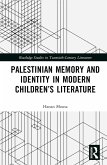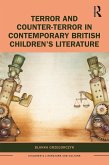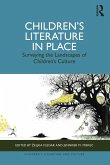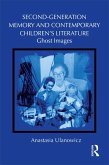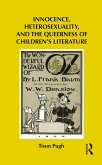Palestinian Memory and Identity in Modern Children's Literature (eBook, PDF)


Alle Infos zum eBook verschenken

Palestinian Memory and Identity in Modern Children's Literature (eBook, PDF)
- Format: PDF
- Merkliste
- Auf die Merkliste
- Bewerten Bewerten
- Teilen
- Produkt teilen
- Produkterinnerung
- Produkterinnerung

Hier können Sie sich einloggen

Bitte loggen Sie sich zunächst in Ihr Kundenkonto ein oder registrieren Sie sich bei bücher.de, um das eBook-Abo tolino select nutzen zu können.
A timely and significant contribution to Palestinian children's literature from 1967 to the present day, Palestinian Memory and Identity in Modern Children's Literatur e examines a myriad of motifs and popular culture and the evolution of national identity and consciousness among young Palestinians. Utilizing analytical and in-depth readings, this text presents a thorough examination of the representations and role of folk culture in Palestinian children's literature from both thematic and stylistic-linguistic perspectives. The analysis covers a wide range of diverse works representing popular…mehr
- Geräte: PC
- mit Kopierschutz
- eBook Hilfe
- Größe: 1.48MB
![Palestinian Memory and Identity in Modern Children's Literature (eBook, ePUB) Palestinian Memory and Identity in Modern Children's Literature (eBook, ePUB)]() Hanan MousaPalestinian Memory and Identity in Modern Children's Literature (eBook, ePUB)42,95 €
Hanan MousaPalestinian Memory and Identity in Modern Children's Literature (eBook, ePUB)42,95 €![Italian Children's Literature and National Identity (eBook, PDF) Italian Children's Literature and National Identity (eBook, PDF)]() Maria TruglioItalian Children's Literature and National Identity (eBook, PDF)43,95 €
Maria TruglioItalian Children's Literature and National Identity (eBook, PDF)43,95 €![Terror and Counter-Terror in Contemporary British Children's Literature (eBook, PDF) Terror and Counter-Terror in Contemporary British Children's Literature (eBook, PDF)]() Blanka GrzegorczykTerror and Counter-Terror in Contemporary British Children's Literature (eBook, PDF)42,95 €
Blanka GrzegorczykTerror and Counter-Terror in Contemporary British Children's Literature (eBook, PDF)42,95 €![Children's Literature in Place (eBook, PDF) Children's Literature in Place (eBook, PDF)]() Children's Literature in Place (eBook, PDF)42,95 €
Children's Literature in Place (eBook, PDF)42,95 €![Second-Generation Memory and Contemporary Children's Literature (eBook, PDF) Second-Generation Memory and Contemporary Children's Literature (eBook, PDF)]() Anastasia UlanowiczSecond-Generation Memory and Contemporary Children's Literature (eBook, PDF)48,95 €
Anastasia UlanowiczSecond-Generation Memory and Contemporary Children's Literature (eBook, PDF)48,95 €![Next-Generation Memory and Ukrainian Canadian Children's Historical Fiction (eBook, PDF) Next-Generation Memory and Ukrainian Canadian Children's Historical Fiction (eBook, PDF)]() Mateusz SwietlickiNext-Generation Memory and Ukrainian Canadian Children's Historical Fiction (eBook, PDF)39,95 €
Mateusz SwietlickiNext-Generation Memory and Ukrainian Canadian Children's Historical Fiction (eBook, PDF)39,95 €![Innocence, Heterosexuality, and the Queerness of Children's Literature (eBook, PDF) Innocence, Heterosexuality, and the Queerness of Children's Literature (eBook, PDF)]() Tison PughInnocence, Heterosexuality, and the Queerness of Children's Literature (eBook, PDF)54,95 €
Tison PughInnocence, Heterosexuality, and the Queerness of Children's Literature (eBook, PDF)54,95 €-
-
-
Dieser Download kann aus rechtlichen Gründen nur mit Rechnungsadresse in A, B, BG, CY, CZ, D, DK, EW, E, FIN, F, GR, HR, H, IRL, I, LT, L, LR, M, NL, PL, P, R, S, SLO, SK ausgeliefert werden.
- Produktdetails
- Verlag: Taylor & Francis eBooks
- Seitenzahl: 158
- Erscheinungstermin: 9. Dezember 2024
- Englisch
- ISBN-13: 9781040150788
- Artikelnr.: 72273641
- Verlag: Taylor & Francis eBooks
- Seitenzahl: 158
- Erscheinungstermin: 9. Dezember 2024
- Englisch
- ISBN-13: 9781040150788
- Artikelnr.: 72273641
- Herstellerkennzeichnung Die Herstellerinformationen sind derzeit nicht verfügbar.
l 4.3. The Use of Folk Tales in the Period 1988-2015 4.3.1. Introduction 4.3.2. Reshaping Folk Tales 4.3.3. The Use of Narration in Folk Tales 4.3.3.1. Forms and Appearances of Narrator Presence in Children's Stories 4.3.3.2. The Use of Narrator Styles in Children's Stories 4.3.4. The Invocation of Traditional Characters in the Second Period 4.3.4.1. The Invocation of the Characters of Al-Sh
tir Hasan (Shater Hasan) and the Gh
l in Children's Stories 4.3.5. The Use of Folk Tale Features in Children's Stories 4.3.5.1. The Use of Styles of Beginning in Children's Stories 4.3.5.2. The Use of Repetitive Styles in Children's Stories 4.4. Summary Chapter 5 - The Use of Popular Proverbs in Palestinian Children's Literature 5.1. Introduction 5.2. The Use of Popular Proverbs in the 1967-87 Period 5.2.1. Introduction 5.2.2. Citing Popular Proverbs in the Vernacular Dialect (al-
mm
ya) Form 5.2.3. Citing Popular Proverbs via Converting Them into Classical Arabic (al-Fü
a) 5.2.4. Citing Popular Proverbs as Titles of Children's Stories (Paratextualism) 5.3. The Use of Popular Proverbs in the 1988-2015 Period 5.3.1. Introduction 5.3.2. Citing Popular Proverbs as Titles of Children's Stories (Paratextualism) 5.3.2.1. Introduction 5.3.2.2. The Concept of Titles 5.3.2.3. Titles in Children's Stories 5.3.2.4. Citing Popular Proverbs in Children's Stories 5.3.2.5. The Dominance of Popular Proverbs and Their Prevalence over the Text 5.4. Summary Chapter 6 - The Use of Popular Songs in Palestinian Children's Literature 6.1. Introduction 6.2. The Use of Popular Songs in the First Period (1967-87) 6.2.1. Introduction 6.2.2. The Use of Popular Song Names and Related Aspects (Allusion) in the First Period 6.2.3. The Citation of Popular Song Names Converted into Classical Arabic (al-Fü
a) Form in the First Period 6.3. The Use of Popular Songs in the 1988-2015 Period 6.3.1. Introduction 6.3.2. The Use of Song Names and Related Aspects (Allusion) in the Second Period 6.3.3. The Use of Popular Songs in Vernacular Dialect (al-
mm
ya) Form 6.3.4. The Use of Popular Songs Converted into Classical Arabic (al-Fü
a)Form 6.3.5. Narration of Popular Song Styles 6.3.6. The Use of Popular Songs as Titles of Children's Stories in the Second Period (Paratextualism) 6.3.7. Summary Conclusion Sources and References 1. List of Sources and References 1.1. Arabic-Language Sources 2. References 2.1. Arabic-Language References 2.2. Foreign-Language References Hebrew-Language References
l 4.3. The Use of Folk Tales in the Period 1988-2015 4.3.1. Introduction 4.3.2. Reshaping Folk Tales 4.3.3. The Use of Narration in Folk Tales 4.3.3.1. Forms and Appearances of Narrator Presence in Children's Stories 4.3.3.2. The Use of Narrator Styles in Children's Stories 4.3.4. The Invocation of Traditional Characters in the Second Period 4.3.4.1. The Invocation of the Characters of Al-Sh
tir Hasan (Shater Hasan) and the Gh
l in Children's Stories 4.3.5. The Use of Folk Tale Features in Children's Stories 4.3.5.1. The Use of Styles of Beginning in Children's Stories 4.3.5.2. The Use of Repetitive Styles in Children's Stories 4.4. Summary Chapter 5 - The Use of Popular Proverbs in Palestinian Children's Literature 5.1. Introduction 5.2. The Use of Popular Proverbs in the 1967-87 Period 5.2.1. Introduction 5.2.2. Citing Popular Proverbs in the Vernacular Dialect (al-
mm
ya) Form 5.2.3. Citing Popular Proverbs via Converting Them into Classical Arabic (al-Fü
a) 5.2.4. Citing Popular Proverbs as Titles of Children's Stories (Paratextualism) 5.3. The Use of Popular Proverbs in the 1988-2015 Period 5.3.1. Introduction 5.3.2. Citing Popular Proverbs as Titles of Children's Stories (Paratextualism) 5.3.2.1. Introduction 5.3.2.2. The Concept of Titles 5.3.2.3. Titles in Children's Stories 5.3.2.4. Citing Popular Proverbs in Children's Stories 5.3.2.5. The Dominance of Popular Proverbs and Their Prevalence over the Text 5.4. Summary Chapter 6 - The Use of Popular Songs in Palestinian Children's Literature 6.1. Introduction 6.2. The Use of Popular Songs in the First Period (1967-87) 6.2.1. Introduction 6.2.2. The Use of Popular Song Names and Related Aspects (Allusion) in the First Period 6.2.3. The Citation of Popular Song Names Converted into Classical Arabic (al-Fü
a) Form in the First Period 6.3. The Use of Popular Songs in the 1988-2015 Period 6.3.1. Introduction 6.3.2. The Use of Song Names and Related Aspects (Allusion) in the Second Period 6.3.3. The Use of Popular Songs in Vernacular Dialect (al-
mm
ya) Form 6.3.4. The Use of Popular Songs Converted into Classical Arabic (al-Fü
a)Form 6.3.5. Narration of Popular Song Styles 6.3.6. The Use of Popular Songs as Titles of Children's Stories in the Second Period (Paratextualism) 6.3.7. Summary Conclusion Sources and References 1. List of Sources and References 1.1. Arabic-Language Sources 2. References 2.1. Arabic-Language References 2.2. Foreign-Language References Hebrew-Language References

